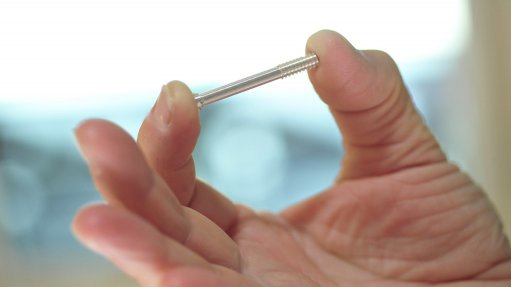
Magnezix bone implant, made from magnesium
The globally unique magnesium-based implant technology successfully developed by Germany-based Syntellix has already obtained product registration and market approval in over 56 countries worldwide, including South Africa where it was introduced in 2015.
The company late last month signed a cooperation contract with Chinese orthopaedic implant supplier Beijing Chunlizhengda Medical Instruments, to tap into the Chinese medical technology market, which is one of the biggest markets in the world, considering China’s 1.5-billion-strong population.
Syntellix founder Dr Utz Claassen told the media during a recent interview in Johannesburg that the implants were particularly effective in public healthcare systems, as it spared the cost of a second procedure to remove an implant – in an already overburdened healthcare system – since the Magnezix implant is bioabsorbable.
In South Africa, Magnezix implants are being used at the Livingstone Hospital, in Port Elizabeth the Frere Hospital, in East London; Chris Hani Baragwanath, in Johannesburg; Charlotte Maxeke Johannesburg Academic Hospital, in Johannesburg; Dr George Mukhari, in Pretoria; and King Edward VIII, in Durban as well as in the private sector.
Magnezix implants are applicable in a variety of indications in orthopaedic and trauma surgery.
The implants can be used in cases of fractures and non-unions of small bones and small bone arthrodesis, including scaphoid fractures, avulsion fractures, medial and lateral malleolar fractures, intra-articular fractures of the tarsals, metatarsals, carpals and metacarpals, bunionectomy and osteotomies around the foot and ankle, arthrodesis of small joints, fractures of patella, ulna and radial styloid fractures, radial head fractures and distal humerus intra-articular fractures.
Magnezix implants are suitable for use in the bones of the elbow, hip, hand, shoulder, knee, ankle and foot.
Syntellix is working on expanding the range of orthopaedic surgery applications that Magnezix can be used for, such as trauma and paediatrics, as well as additional markets in future – neuro and dental surgery.
The Magnezix offering currently comprises the CS, Pin, CBS and StarFuse products, with each having respective functions, properties and uses.
Claassen noted that more than 46 000 units have been sold worldwide.
Syntellix aims to impact one-billion people in 20 years, creating exponential benefit to patients, hospitals, doctors, health systems and the environment.
BENEFICIAL TO THE BONE
Magnezix combines the advantages of the stability of conventional steel or titanium implants and the degradation properties of resorbable implants, such as polymers.
The bioabsorbable metal implant dissolves completely in the bone as the bone heals, so the rate of its absorption varies. The mechanical properties of magnesium are close to those of human bone, making it a suitable material for these stable, yet reabsorbable, implants.
The implants have the added advantage of antibacterial properties, which helps to prevent infections in the bone.
The risk of infection is also reduced since there is no second surgery to remove an implant, as is the case with titanium implants.
Claassen said magnesium would disrupt titanium as the leading material for orthopaedic implants, similar to how titanium, in turn, disrupted steel implants.
Conventional implants also often cause stress-shielding, which could leave the bone prone to a refracture later in life.
Polymers, in particular, have less stability and, when dissolved, they usually leave a hole in the bone, meaning the bone is not as strong as it was before the fracture.
In essence, Magnezix offers patients a faster, more cost-effective and safer recovery process. The implant results in less pain, a lower risk of infection and a faster healing time.
“The broad use of the absorbable magnesium reduces unnecessary interventions and sick leave, relieves healthcare providers and offers cost bearers in the healthcare system savings potential – while simultaneously enhancing the quality of treatment. Likewise, surgeons who use this product save resources and time, while helping their patients achieve maximum restorative results,” Claassen pointed out.
Different from polylactide and titanium, magnesium is a body-affine material that the human body explicitly needs, while the body does not need intake of titanium.
Claassen said 300 enzymes were activated by magnesium, which was crucial for human metabolism and basic body functions. The recommended daily dietary intake of magnesium is between 375 mg and 500 mg, which the Magnezix implant will not exceed, even if multiple implants are installed.
Further, magnesium implants show significantly less artefacts in magnetic resonance imaging, while titanium implants cause artefacts in these scans, often hindering correct diagnostics.
In case of osteolysis of the fragment, meaning a protruding metallic screw head from the bone, magnesium will not damage the healthy cartilage in the surrounds, while protruding titanium would be damaging.